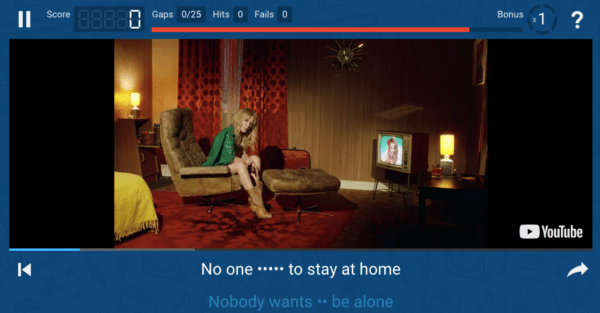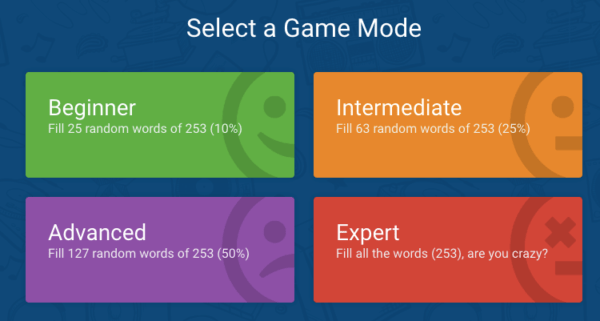Learning English Through Lyrics
by Greg Kessler
 I thought it might be fun to start this blog out with a song. As most English teachers know, music can be a great way to engage learners to listen extensively and intensively. Music can make learning English fun while allowing teachers to focus on any of these aspects that are relevant to their current teaching. It can provide students with welcome opportunities to listen repeatedly and carefully to understand the English lyrics. Lyrics can be used as a source of authentic language to support the instruction of all language skills.
I thought it might be fun to start this blog out with a song. As most English teachers know, music can be a great way to engage learners to listen extensively and intensively. Music can make learning English fun while allowing teachers to focus on any of these aspects that are relevant to their current teaching. It can provide students with welcome opportunities to listen repeatedly and carefully to understand the English lyrics. Lyrics can be used as a source of authentic language to support the instruction of all language skills.
Very early in my career I had the opportunity to create my own classes using interesting resources. One of the first ones that I created was a class built around music and lyrics. It was an integrated skills class that intentionally shifted focus to speaking and pronunciation, listening, reading, writing, and grammar as course material and student needs allowed. Songs were intentionally selected to address each of these areas as well as to appeal to students’ personal musical interests. This class was completely paper-based and the music was played on cassettes.
Today, a variety of websites present opportunities for learners to interact with music and lyrics in a variety of ways. Songs and lyrics are easy to find on the Internet. It is also easy to find examples of fan created video mashups, including their favorite songs and performers. If fans are doing this sort of thing on their own, I think we can welcome similar activities in the language classroom. Students can reflect on the language of lyrics and respond through their own creations. They can create alternate versions of lyrics, changing grammatical forms, song settings, or characters to address language goals.
Some sites also allow learners across a continuum of abilities to practice interacting with English. Many of these sites provide learners with opportunities to adjust enhancements so that they are most salient for their particular needs at that specific point in their acquisition process. Like so many recent developments in educational technology, these sites put the control in the hands of students, which allows them to take responsibility for their own learning and engage meaningfully in the process.
New resources are always available; one current example that I like is Lyrics Training. This website presents learners with a lot of control and numerous options. When they enter the site, learners have the option of choosing from four levels of difficulty. As you can see they offer a range of challenges.

Once a level is selected, learners can interact with the music videos in progressively more challenging ways. Each phrase or sentence is presented for students to complete as they anticipate the next one, as can be seen in this photo:

Learners are also invited to compete with others, upload their favorite lyrics, and save their favorites. There is also a portal for teachers to be able to manage students’ performance. Lyrics training also provides resources for learning 11 other languages so instructors who work across languages may find this useful.
There are many helpful resources online for guiding teachers in using music in the ESL and EFL classroom. Here are a few of my favorites:
Teachers can use songs, lyrics, and music videos in so many creative ways to design engaging learning experiences. As I often say, you are only limited by your own imagination and creativity.
In the next episode we will look at some other resources for using video in English learning. Some of these also support the use of music and lyrics, but they also present a variety of authentic examples of spoken English in ways that allow learners to control delivery and access to the resources.
Want more ideas for integrating music into your lessons? Check out New Ways in Teaching With Music from TESOL Press.
*This article first appeared on the TESOL Blog, 15 March 2018.
Greg Kessler is associate professor of instructional technology in the Patton College of Education at Ohio University. He has written numerous books, articles, book chapters, and other publications. He has delivered keynote and featured talks around the world. His research addresses technology, learning, and language use with an emphasis on teacher preparation. He has held numerous leadership positions, including as Ohio TESOL president, CALICO president, and TESOL CALL IS chair. He is the editor of the CALICO book series, Advances in CALL Practice & Research, the Language Learning & Technology journal forum, Language Teaching & Technology, and many other comprehensive collections.
TESOL Blogs
Interested in writing a blog for TESOL?
Read the submission guidelines and send us your post!
Check out some of the most-read TESOL Blog posts this year:
|
Six Strategies for Teaching ELLs Across the Content Areas, by Judie Haynes
 The role of the ESL teacher is changing. According to the TESOL’s Implementing the Common Core State Standards for English Learners: The Changing Role of the ESL Teacher, “ESL teachers should be recognized as experts, consultants, and trainers well versed. Read more. The role of the ESL teacher is changing. According to the TESOL’s Implementing the Common Core State Standards for English Learners: The Changing Role of the ESL Teacher, “ESL teachers should be recognized as experts, consultants, and trainers well versed. Read more.
|
|
8 Current Trends in Teaching and Learning EFL/ESL, by Deena Boraie
 The TESOL President’s Blog Last month, I had the good fortune of having been invited as a plenary speaker in MexTESOL’s 40th anniversary convention, held in lovely Querétaro. I had a wonderful time, and I really felt at home—I discovered... Read more The TESOL President’s Blog Last month, I had the good fortune of having been invited as a plenary speaker in MexTESOL’s 40th anniversary convention, held in lovely Querétaro. I had a wonderful time, and I really felt at home—I discovered... Read more
|